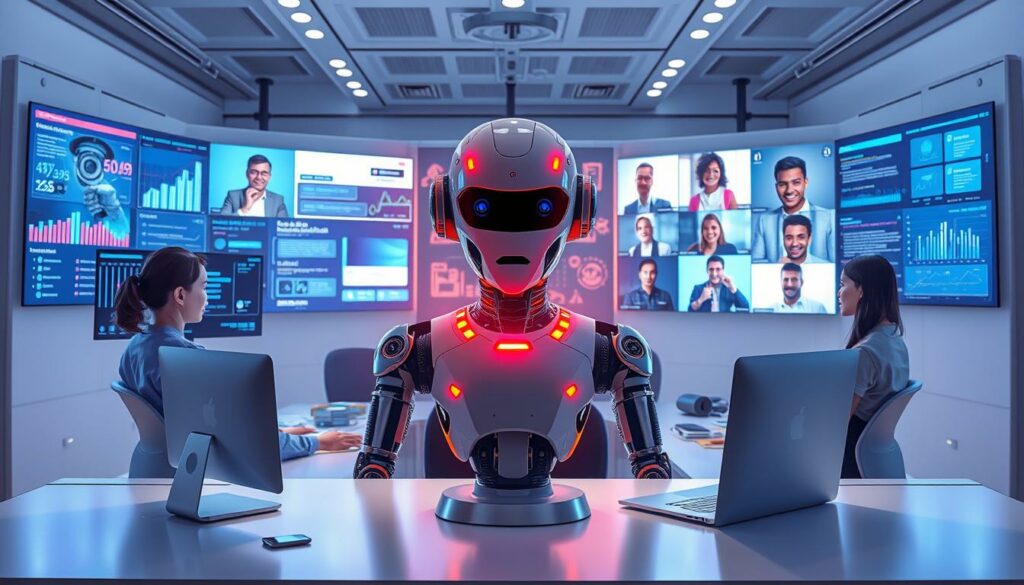With more companies adopting the hybrid work model, the use of AI technologies is growing. These technologies help improve teamwork and productivity among remote workers. One key tool is the AI agent for remote team collaboration. It’s designed to boost interaction and workflows, making teamwork smooth.
Unlike traditional ways of communicating, AI agents aren’t limited by location or time zones. They offer a new way of working together that is always on and fully integrated. This means teams can work more closely than ever before.
Today, over 35 million U.S. workers work remotely. AI technologies are perfect for meeting their needs. By using AI for team collaboration, we can remove common issues that remote work faces. This allows teams to automate daily tasks and gain insights instantly. As a result, team members can spend more time on important projects. This boosts both efficiency and creativity.
Key Takeaways
- AI agents are transforming remote team collaboration with seamless communication and efficient workflows.
- The hybrid work model is supported by AI’s capability to integrate teams across different locations.
- Over 35 million U.S. workers benefit from these advanced AI technologies.
- AI agents ensure continuous, integrated team interaction, reimagining workplace collaboration.
- Automation of routine tasks allows individuals to focus on strategic work, increasing productivity and innovation.
Understanding AI Agents in Remote Work Environments
AI agents are now key in remote work, acting on their own in changing settings. They help make teams spread out over different areas work better together. This boosts both efficiency and connection.
Definition and Capabilities
These AI tools work by themselves, thanks to learning machines, data study, and understanding human language. We see different types including:
- Simple Reflex Agents: React instantly to stimuli based on pre-programmed rules.
- Model-Based Reflex Agents: Use an internal model of the environment to manage partially observable situations.
- Goal-Based Agents: Employ planning algorithms to achieve specified objectives.
- Utility-Based Agents: Make choices that maximize a utility function’s value or desirability.
- Learning Agents: Adapt and improve their performance over time through experience.
Difference Between Bots and Autonomous Agents
Bots and autonomous agents both play roles in tech like robotics and chat services. Yet, bots follow strict, set rules. AI agents, however, can handle multiple, complex steps. They grow and learn from the data they get. For example, Google’s SIMA works in 3D gaming. Also, Cognition AI’s Devin, an AI-powered collaboration platform, is very accurate at fixing coding issues.
Importance in Remote Team Collaboration
AI agents, such as Salesforce’s Agentforce, boost creativity and get jobs done by handling tasks automatically. They also improve talking and planning in real-time across the team. These agents change how we see workspaces, making sure teams can work smoothly, even when far apart. Having a virtual agent keeps the workflow going, showing why they’re essential in today’s remote work world.
| Agent Type | Main Function | Examples |
|---|---|---|
| Simple Reflex Agents | Immediate reaction to stimuli | Thermostats, vending machines |
| Model-Based Reflex Agents | Managing partially observable environments | Street lamp sensors, self-driving cars |
| Goal-Based Agents | Achieving specific objectives | Path-planning robots, game-playing AI |
| Utility-Based Agents | Maximizing desired outcomes | Navigation apps, chatbots |
| Learning Agents | Adapting and improving performance | Robot vacuum cleaners, personal assistants |
Key Benefits of AI Agents for Remote Team Collaboration
AI agents are changing the way remote teams work together. They use advanced tech to make teamwork smoother and more efficient. This brings several benefits that make working together better.
Enhanced Productivity and Innovation
AI agents greatly improve remote team productivity. They handle routine tasks like scheduling and meeting summaries. This lets team members focus on more creative and strategic work.
Their use leads to higher efficiency and promotes a culture of innovation and creativity.

Automated Task Management
AI agents act as a virtual assistant for teamwork. They automate many time-consuming tasks. This includes generating reports and analyzing big data sets for useful insights.
For instance, HappyFox uses AI to create ticket summaries. This makes it easy for remote teams to understand and act on long communications quickly.
Real-time Communication and Updates
For remote teams, especially in different time zones, real-time communication is key. AI agents provide smart technology for team collaboration. They make sure everyone gets updates about projects right away.
This instant sharing of information is crucial. It helps with making quick, informed decisions. It also keeps the team in sync and improves how they work together.
| Benefits | Details |
|---|---|
| Boosting Productivity | Through automating routine tasks like scheduling and data analysis. |
| Enhancing Customer Experience | By rapidly addressing and resolving common issues, such as login problems and password resets. |
| Data-driven Insights | Providing real-time, data-driven insights for faster decision-making. |
Top AI-powered Collaboration Platforms
AI-powered collaboration platforms have changed how teams work together, especially when apart. Slack, with generative AI tools, is crucial for many users globally. It makes searching smarter, improves communication, and summarizes daily tasks. These features help manage teams that are spread out.

Zoom Workplace is another top tool that uses AI to change how teams collaborate. It recently added 40 new features. These include the AI-powered Zoom Contact Center and the Ask AI Companion tool. They enhance customer relations and help agents be more efficient.
The Ask AI tool also organizes and shares info from Zoom Meetings, Mail, and more. Users get summaries after calls, tips on what to do next, and help with voicemails. This makes teams more productive and connected.
Google Docs lets teams work on documents together without waiting. This AI platform is great for live collaboration, boosting productivity a lot. Microsoft Office 365 also offers many tools for teamwork, like Word and PowerPoint. It’s subscription-based and aids in different collaboration needs.
Companies like DigitalOcean provide the needed digital tools for these AI platforms. They make sure these platforms can work well even for big companies. JustCall Workspace gives new users three months free and special onboarding. This helps teams start using AI in their work.
| Platform | Key Features |
|---|---|
| Slack | Integrates generative AI tools, smarter searches, daily activity recap |
| Zoom Workplace | AI-powered innovations, tool integrations, enhanced customer relationships |
| Google Docs | Real-time simultaneous collaboration |
| Microsoft Office 365 | Includes Word, Excel, PowerPoint, Outlook, and OneDrive |
| JustCall Workspace | Three months free, white-glove onboarding |
In conclusion, AI tools for team collaboration are making remote work much better. By using these platforms, companies can work together more effectively. They ensure smooth communication across teams far apart. Investing in these tools boosts productivity and connects teams like never before.
Challenges and Solutions in Implementing AI Agents
Introducing AI into remote work can change things for the better but has issues. The problem of “fake AI” solutions has made people skeptical. To fight this, use real, effective systems like AI Summarization tools. These create detailed reports from remote sessions. An example is ScreenMeet’s AI, which boosts productivity and solves problems faster. This leads to lower costs and higher ROI.
Sometimes, people resist new tech. It’s important to train them well. Another big issue is security. Using AI could open up security risks. Companies like Onix focus on making their AI solutions safe and trustworthy.
Linking AI with current systems seems hard. Start integrating in phases to ease into it and fix problems on the way. Adding a virtual assistant can make teamwork better. It works best if it’s easy to use and has good support. This can help more people use it.
Keep supporting the AI to ensure it works well with team productivity tools. AI like OpenAgents and TaskMatrix are good at this. They can make work flow better and keep productivity high.
The AI market is growing fast. It was worth $4.8 billion in 2023 and could reach $28.5 billion by 2028. Companies like Superagent, known for their analytics, and Adala, for adaptable solutions, show how AI can solve varied problems.
| Challenge | Solution | Example |
|---|---|---|
| Resistance to new technologies | Comprehensive training | Onix’s training programs |
| Security concerns | Robust security measures | Onix’s enterprise-level solutions |
| Complex integration | Phased integration strategy | TaskMatrix’s integration capabilities |
By overcoming these challenges, companies can make the most of AI. This will boost productivity and spark new ideas.
Conclusion
As we end our talk, we see AI agents changing business a lot. Companies are now operating smarter and faster. 60% of them use AI for better team work over distance. This has helped big names like Amazon run smoother. They enjoy better customer service, keep inventory well, and send out goods more efficiently.
AI does more than just make jobs easier. It’s improving how remote teams talk and work together. A huge 75% boost in teamwork and a 60% jump in getting things done have been seen. Plus, these tools are right 85% of the time when making work flow better. They also make sure teams feel more connected.
But, adding AI to remote work needs careful planning. Things like training staff, managing data, and keeping data safe are crucial. While some worry about machines replacing people, with the right steps, these issues can be lessened. Want more info on AI? Check out this detailed piece on AI and CRM System Integration.
The future looks bright for AI in managing remote teams. Experts predict a 90% jump in how advanced these solutions will become. Adopting AI means preparing for a strong future. It’s about more than keeping up; it’s about creating a thriving space. Virtual tools for teamwork will help businesses excel in a digital world. They keep teams strong, efficient, and full of new ideas.
FAQ
What is an AI agent for remote team collaboration?
An AI agent helps remote teams work better together. It is a smart tool that makes communication smooth and tasks easy. It works all the time to keep the team connected, no matter where they are.
How do AI agents differ from traditional bots?
AI agents can handle complex tasks by themselves, unlike traditional bots that need clear instructions. This is why they’re great for remote work, where tasks can change quickly.
Why are AI agents important in remote team collaboration?
AI agents boost productivity and make communication clearer. They handle routine tasks and analyze data. This lets team members focus on more important work and make quick, informed decisions.
What are the key benefits of using AI agents for remote team collaboration?
Using AI agents increases productivity and sparks innovation. They take care of boring tasks and keep everyone updated. This helps everyone focus on what really matters.
Which platforms exemplify AI-powered collaboration for remote teams?
Salesforce’s Agentforce and Slack AI are leading the way in AI for teamwork. They improve how we talk to each other, automate tasks, and understand our questions better.
What challenges might businesses face when implementing AI agents for remote team collaboration?
Businesses might worry about security, how hard it is to start, and trying new tech. But, with good training, strong security, and taking it step by step, these issues can be solved.
How can businesses overcome the challenges of implementing AI agents?
Offering thorough training, making sure the system is secure, and introducing the tech slowly can help. Also, making sure the tech is easy to use and support is available is key.
How do AI agents contribute to team synchronization in different time zones?
AI agents keep everyone up-to-date and provide valuable insights. This helps teams make decisions fast and stay in sync, even when they’re in different time zones.



